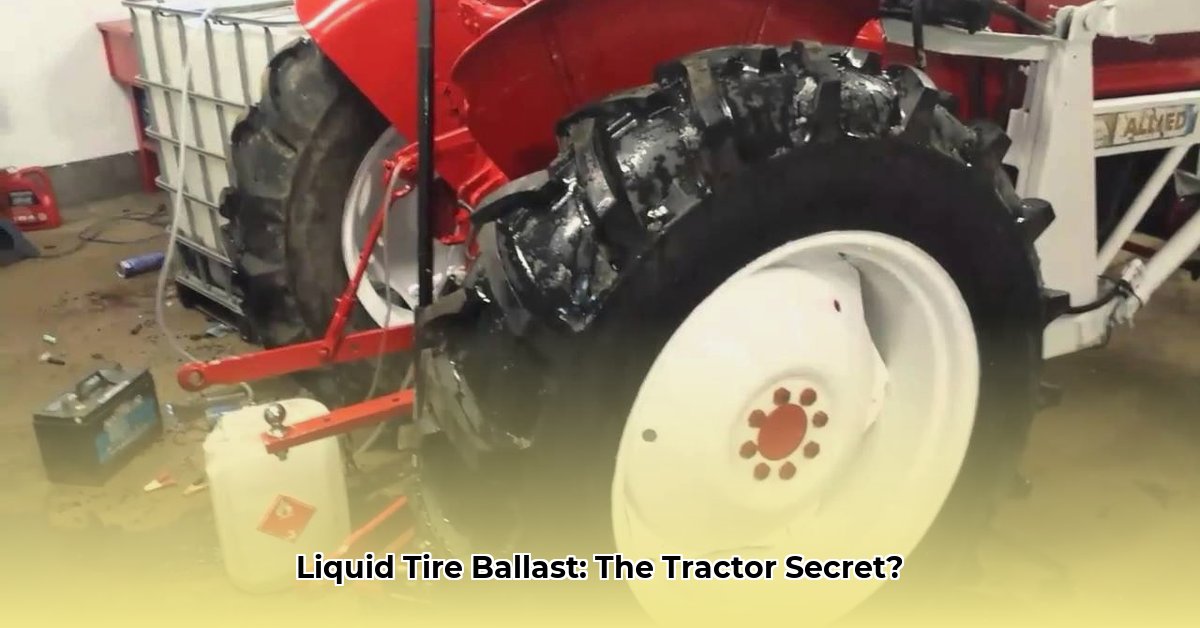
Adding liquid ballast to your tractor tires significantly improves traction and stability, especially on slopes or when hauling heavy loads. But choosing the right ballast can be challenging. This guide simplifies the decision-making process, helping you select the optimal ballast for your specific needs and conditions. We'll compare various types, provide step-by-step installation instructions, and offer maintenance tips to keep your tires in top shape. For more on calcium chloride, see this resource.
Understanding Your Ballast Options: Beyond Water
Several liquids can serve as ballast, each with distinct advantages and disadvantages. Choosing the right one depends on your climate, budget, and environmental concerns.
Water: Inexpensive and readily available, water is a simple solution, but it freezes easily in colder climates, potentially damaging your tires. This makes it suitable only in milder regions.
Antifreeze (Ethylene Glycol): Offers excellent freeze protection. However, it's highly toxic and harmful to the environment. While effective, its environmental impact is significant.
Antifreeze (Propylene Glycol): A less toxic alternative to ethylene glycol, providing good freeze protection. While still not environmentally ideal, it's a comparatively better choice than ethylene glycol.
Calcium Chloride: Cost-effective and highly resistant to freezing. However, it's highly corrosive to rims, leading to costly repairs if not carefully monitored.
Beet Juice (RimGuard): A non-toxic, biodegradable, and environmentally friendly option. While highly effective and long-lasting, it's the most expensive option.
Windshield Washer Fluid: Not recommended as a primary ballast due to its limited weight increase and potentially harmful chemical composition. It should only be considered for minor, temporary weight adjustments.
Isn't it crucial to understand the long-term implications of each ballast type? For example, the seemingly inexpensive choice of water may lead to costly repairs in freezing climates.
| Ballast Type | Pros | Cons | Cost | Environmental Impact | Notes |
|---|---|---|---|---|---|
| Water | Inexpensive, readily available | Freezes easily, limited weight | Low | Low | Best for mild climates, short-term use |
| Antifreeze (Ethylene Glycol) | Excellent freeze protection | Toxic, very harmful to the environment, expensive | Medium | High | Avoid if possible; environmentally damaging. |
| Antifreeze (Propylene Glycol) | Good freeze protection, less toxic than ethylene glycol | Still toxic, expensive | Medium | Medium | Less environmentally damaging option than ethylene glycol. |
| Calcium Chloride | Excellent freeze protection | Highly corrosive to rims, potentially damaging to the environment | Low | Medium | Requires careful monitoring, regular rim inspections, potential for costly rim damage. |
| Beet Juice (RimGuard) | Non-toxic, biodegradable, environmentally friendly, long-lasting | Expensive | High | Low | Excellent long-term solution for environmentally conscious farmers |
| Windshield Washer Fluid | Inexpensive | Limited weight, contains potentially harmful chemicals | Low | Medium | Not recommended as a primary ballast; use only for minor weight increases. |
Choosing the Right Ballast: A Step-by-Step Guide
Selecting the appropriate ballast involves considering your specific circumstances. This step-by-step guide will help you make an informed decision.
Step 1: Climate Assessment: Harsh winters necessitate freeze-resistant solutions like propylene glycol antifreeze or careful monitoring of calcium chloride. Milder climates provide more flexibility, allowing for water or beet juice.
Step 2: Budgetary Considerations: Water and windshield washer fluid are the cheapest, while beet juice is the most expensive. Weigh the initial investment against long-term costs and potential damage from freezing or corrosion.
Step 3: Environmental Priorities: Prioritize environmental impact by choosing beet juice if environmental sustainability is paramount. Otherwise, weigh the trade-offs between cost-effectiveness and environmental impact with other options.
Step 4: Tractor Age and Rim Condition: Avoid calcium chloride on older tractors with potentially weaker rims. Regular rim inspection is crucial regardless of the chosen ballast.
This decision-making process is further clarified by the following decision tree:
Start
|
Harsh Winters?
/ \
Yes No
/ \
Corrosion Resistant Rims? Water Suitable?
/ \
Yes No
/ \
Calcium Chloride (Careful Monitoring) Beet Juice (Best Overall)
\ /
\ /
\ /
\ /
\ /
\ /
\ /
\ /
\/
End
Safe Ballast Installation and Maintenance
Proper installation and maintenance are crucial for safety and tire longevity.
Step 1: Thorough Cleaning: Clean the tire valve and rim to ensure a proper seal.
Step 2: Appropriate Equipment: Use the correct filling equipment for your chosen ballast.
Step 3: Gradual Filling: Fill the tires slowly to avoid internal tire damage or pressure surges, regularly monitoring the pressure.
Step 4: Recommended Pressure: Inflate the tires to the manufacturer's recommended pressure after filling.
Step 5: Regular Inspections: Regularly inspect tires and rims for leaks, damage, or corrosion. Early detection prevents major issues.
Remember that safe handling and responsible disposal are essential. Always follow manufacturer instructions and comply with safety regulations.
Real-World Examples
Farmers have reported success with various ballasts. Water proves cost-effective in mild climates, while beet juice’s environmental friendliness is highly valued, albeit at a higher cost. Conversely, experiences with calcium chloride highlight the importance of regular rim inspection. These examples underscore the importance of matching ballasts to individual farming contexts.
Frequently Asked Questions (FAQs)
Q: How corrosive is calcium chloride? A: Highly corrosive; regular rim inspections are essential.
Q: Can I mix different ballasts? A: Mixing is generally not recommended, as it may lead to unforeseen chemical reactions and damage.
Q: How should I dispose of used ballast? A: Dispose of used ballast responsibly, according to local regulations.
By carefully considering your specific needs, you can make an informed decision about the most suitable liquid ballast for your tractor tires. Remember that consistent monitoring and proper maintenance are vital for maximizing tire lifespan and ensuring both operational efficiency and environmental responsibility.